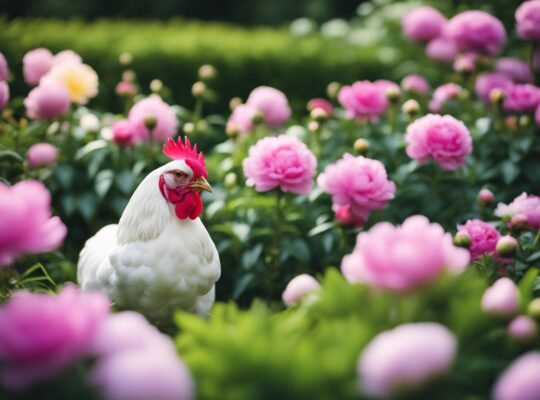If you have chickens and hydrangeas in your backyard, you may be wondering if hydrangeas are poisonous to chickens. Hydrangeas are popular ornamental plants that produce beautiful flowers in shades of pink, blue, and purple. However, not all parts of the hydrangea plant are safe for chickens to consume.
Common Names of Hydrangeas
Hydrangeas are also known as hortensia, French hydrangea, and mophead hydrangea. There are over 70 species of hydrangeas, and they are native to Asia and the Americas. Some of the most common species of hydrangeas include:
- Hydrangea macrophylla
- Hydrangea arborescens
- Hydrangea paniculata
- Hydrangea quercifolia
While hydrangeas are beautiful plants, they contain toxins that can be harmful to chickens.
Hydrangeas contain cyanogenic glycosides, which can release hydrogen cyanide when ingested. Hydrogen cyanide is a poisonous gas that can cause respiratory failure and death in chickens. The highest concentration of cyanogenic glycosides is found in the leaves and flowers of the hydrangea plant.
If you have chickens, it’s important to keep hydrangeas out of their reach. Chickens are curious creatures and may try to eat anything within their reach, including hydrangeas. Make sure to fence off your hydrangea plants or keep your chickens away from them to prevent accidental ingestion.
Symptoms of Hydrangea Poisoning in Chickens
If you suspect that your chickens have ingested hydrangeas, it is essential to be aware of the symptoms of hydrangea poisoning. Symptoms of hydrangea poisoning in chickens can vary depending on the amount of plant material ingested and the individual bird’s susceptibility.
Upper Respiratory Tract Symptoms
One of the most common symptoms of hydrangea poisoning in chickens is upper respiratory tract symptoms. These symptoms can include coughing, sneezing, and difficulty breathing. Chickens may also display nasal discharge and a runny nose.
Blood-Related Symptoms
Hydrangea poisoning can also cause blood-related symptoms in chickens. Chickens may develop pale combs and wattles due to anemia. They may also experience a decrease in egg production and may lay eggs with thin shells or no shells at all.
Other symptoms of hydrangea poisoning in chickens can include vomiting, depression, diarrhea, and gastrointestinal disturbances. Chickens may also display clinical signs such as confusion, weakness, and lethargy.
It is important to note that not all chickens will display symptoms of hydrangea poisoning, and some may be more susceptible than others. If you suspect that your chickens have ingested hydrangeas, it is essential to contact your veterinarian immediately.
Treatment and Prevention
Contacting a Veterinarian
If you suspect that your chickens have ingested hydrangea, it is important to contact your local veterinarian immediately. They will be able to provide you with advice on what to do next and if medical attention is necessary. Symptoms of hydrangea poisoning in chickens can include vomiting, diarrhea, lethargy, and difficulty breathing.
Preventing Access to Hydrangeas
Preventing access to hydrangeas is the best way to prevent poisoning in chickens. You can do this by ensuring that hydrangeas are not planted in areas where chickens can access them. If you have hydrangeas in your garden, consider fencing off the area or using chicken wire to create a barrier around the plants.
It is also important to ensure that any cuttings or fallen flowers from hydrangeas are removed from the area where your chickens roam. Chickens are curious creatures and may try to eat anything they come across, so it is important to keep the area around their coop and run free of any potentially harmful plants or debris.
In addition to preventing access to hydrangeas, it is important to provide your chickens with a balanced diet that includes plenty of fresh water and access to grit. Grit is essential for chickens as it helps them to digest their food properly and can prevent them from eating harmful substances like plants.
Overall, prevention is key when it comes to hydrangea poisoning in chickens. By taking steps to prevent access to the plant and providing your chickens with a healthy diet, you can help to keep them safe and healthy. Remember, if you suspect that your chickens have ingested hydrangea, contact your local veterinarian immediately for advice on what to do next.
Other Potentially Toxic Plants
When it comes to raising chickens, it’s essential to be aware of the plants around your coop and run area. While some plants can be beneficial to your birds, others can be toxic and potentially fatal. In this section, we’ll cover some common and less common toxic plants that you should be aware of.
Common Toxic Plants
Some of the most common toxic plants that you may find around your chicken coop include nightshade, lily of the valley, and rhododendron. These plants contain toxins that can cause vomiting, diarrhea, and even death in chickens if ingested in large enough quantities.
Another common toxic plant is the oleander. All parts of this plant are toxic, and even small amounts can be deadly to chickens. Symptoms of oleander poisoning include diarrhea, vomiting, and difficulty breathing.
Less Common Toxic Plants
While the plants listed above are more common, there are many other plants that can be toxic to chickens. For example, the castor bean plant contains a toxin called ricin, which can cause severe illness or death in chickens if ingested.
Some ornamental plants, such as clematis and foxglove, can also be toxic to chickens. These plants contain chemicals that can cause vomiting, diarrhea, and heart problems.
Fungi, such as mushrooms, can also be toxic to chickens. While some mushrooms are safe to eat, others can be deadly. It’s essential to be able to identify safe mushrooms from toxic ones to keep your chickens safe.
To keep your chickens safe, it’s essential to be aware of the plants in and around your coop and run area. If you’re unsure about a particular plant, it’s best to remove it or keep your chickens away from it until you can confirm whether or not it’s safe.







